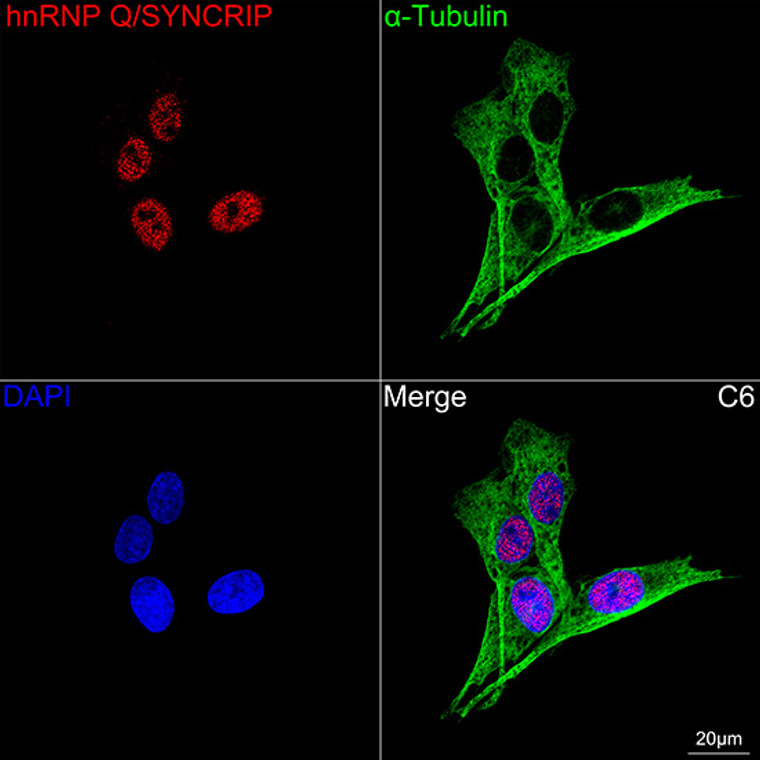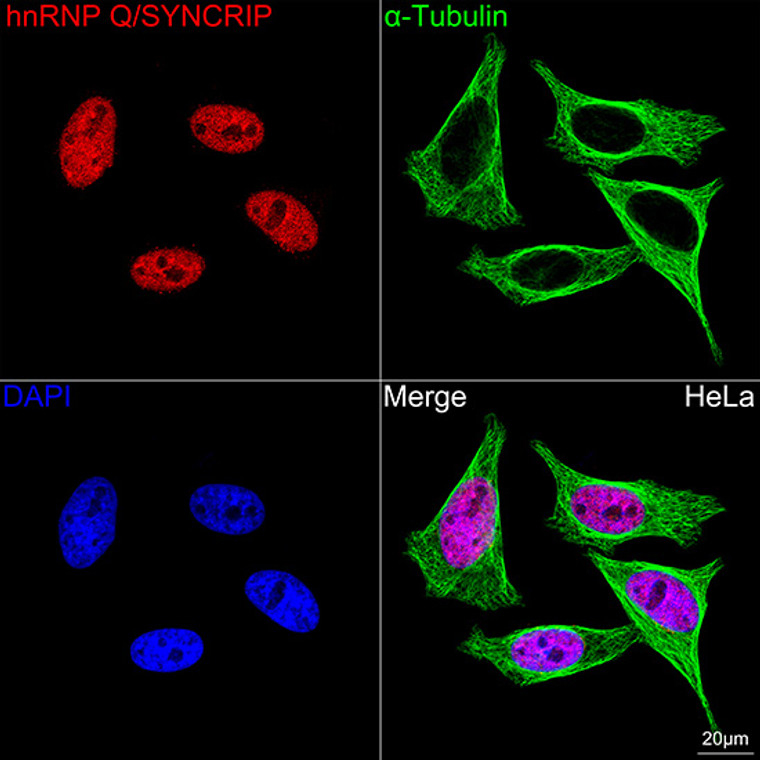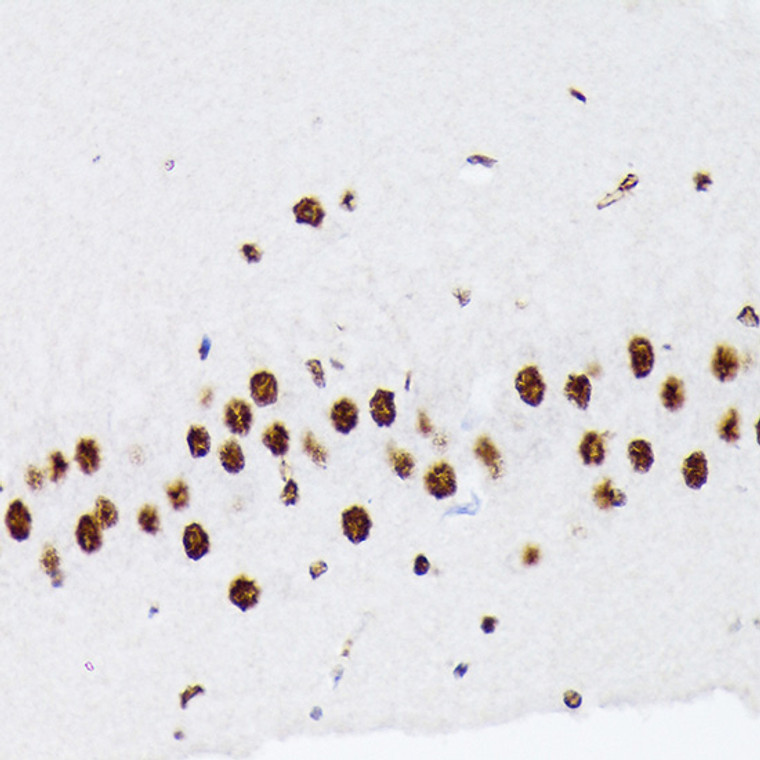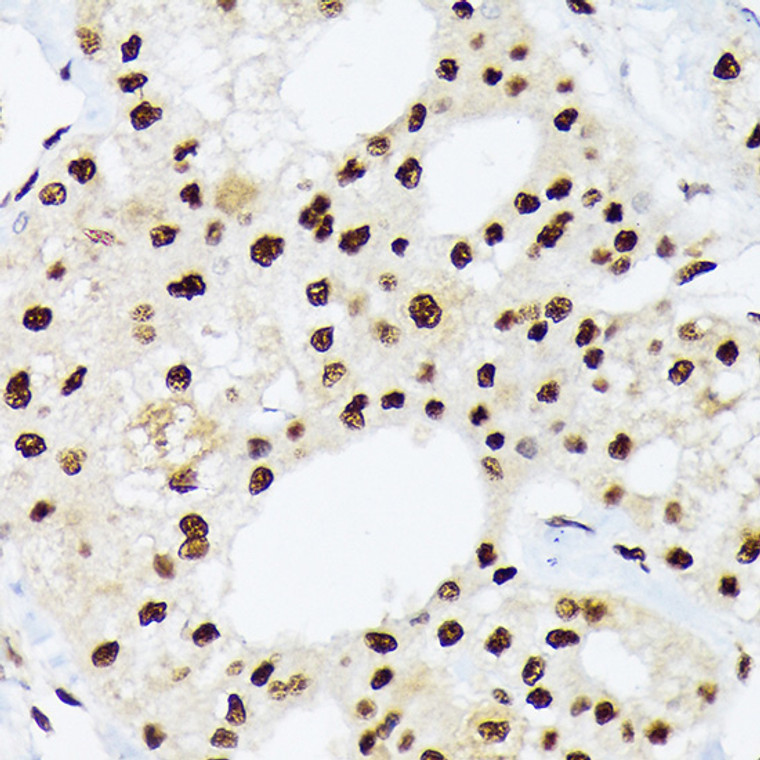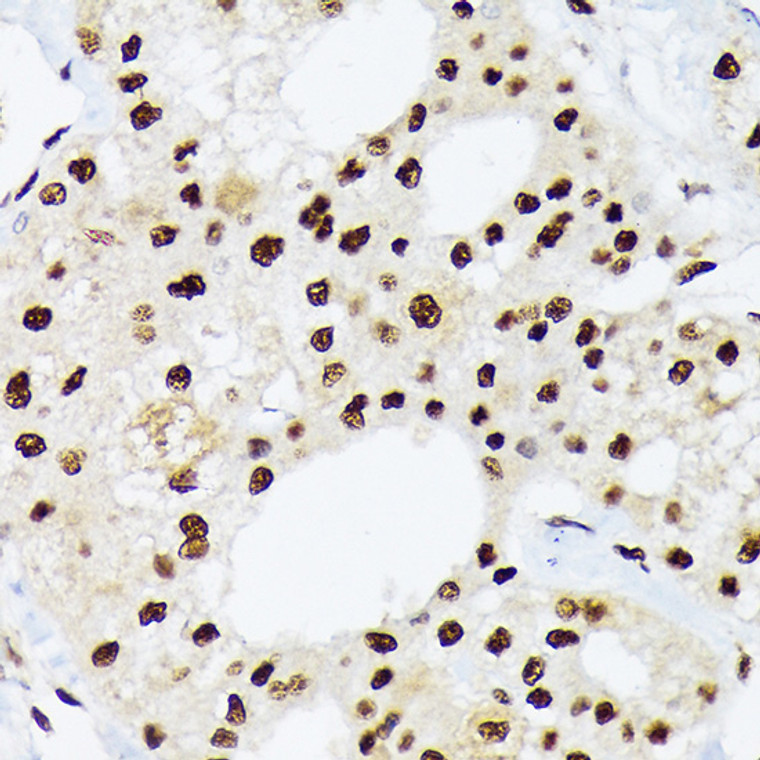| Host: |
Rabbit |
| Applications: |
WB/IHC/IF |
| Reactivity: |
Human/Mouse/Rat |
| Note: |
STRICTLY FOR FURTHER SCIENTIFIC RESEARCH USE ONLY (RUO). MUST NOT TO BE USED IN DIAGNOSTIC OR THERAPEUTIC APPLICATIONS. |
| Short Description: |
Rabbit monoclonal antibody anti-hnRNP Q (524-623) is suitable for use in Western Blot, Immunohistochemistry and Immunofluorescence research applications. |
| Clonality: |
Monoclonal |
| Clone ID: |
S4MR |
| Conjugation: |
Unconjugated |
| Isotype: |
IgG |
| Formulation: |
PBS with 0.02% Sodium Azide, 0.05% BSA, 50% Glycerol, pH7.3. |
| Purification: |
Affinity purification |
| Dilution Range: |
WB 1:500-1:2000IHC-P 1:50-1:200IF/ICC 1:50-1:200 |
| Storage Instruction: |
Store at-20°C for up to 1 year from the date of receipt, and avoid repeat freeze-thaw cycles. |
| Gene Symbol: |
SYNCRIP |
| Gene ID: |
10492 |
| Uniprot ID: |
HNRPQ_HUMAN |
| Immunogen Region: |
524-623 |
| Immunogen: |
A synthetic peptide corresponding to a sequence within amino acids 524-623 of human hnRNP Q/SYNCRIP (O60506). |
| Immunogen Sequence: |
SQRGGPGSARGVRGARGGAQ QQRGRGVRGARGGRGGNVGG KRKADGYNQPDSKRRQTNNQ NWGSQPIAQQPLQGGDHSGN YGYKSENQEFYQDTFGQQWK |
| Tissue Specificity | Ubiquitously expressed. Detected in heart, brain, pancreas, placenta, spleen, lung, liver, skeletal muscle, kidney, thymus, prostate, uterus, small intestine, colon, peripheral blood and testis. |
| Post Translational Modifications | Phosphorylated on tyrosine. The membrane-bound form found in microsomes is phosphorylated in vitro by insulin receptor tyrosine kinase (INSR). Phosphorylation is inhibited upon binding to RNA, whereas the cytoplasmic form is poorly phosphorylated. |
| Function | Heterogenous nuclear ribonucleoprotein (hnRNP) implicated in mRNA processing mechanisms. Component of the CRD-mediated complex that promotes MYC mRNA stability. Isoform 1, isoform 2 and isoform 3 are associated in vitro with pre-mRNA, splicing intermediates and mature mRNA protein complexes. Isoform 1 binds to apoB mRNA AU-rich sequences. Isoform 1 is part of the APOB mRNA editosome complex and may modulate the postranscriptional C to U RNA-editing of the APOB mRNA through either by binding to A1CF (APOBEC1 complementation factor), to APOBEC1 or to RNA itself. May be involved in translationally coupled mRNA turnover. Implicated with other RNA-binding proteins in the cytoplasmic deadenylation/translational and decay interplay of the FOS mRNA mediated by the major coding-region determinant of instability (mCRD) domain. Interacts in vitro preferentially with poly(A) and poly(U) RNA sequences. Isoform 3 may be involved in cytoplasmic vesicle-based mRNA transport through interaction with synaptotagmins. Component of the GAIT (gamma interferon-activated inhibitor of translation) complex which mediates interferon-gamma-induced transcript-selective translation inhibition in inflammation processes. Upon interferon-gamma activation assembles into the GAIT complex which binds to stem loop-containing GAIT elements in the 3'-UTR of diverse inflammatory mRNAs (such as ceruplasmin) and suppresses their translation.seems not to be essential for GAIT complex function. |
| Protein Name | Heterogeneous Nuclear Ribonucleoprotein QHnrnp QGlycine- And Tyrosine-Rich Rna-Binding ProteinGry-RbpNs1-Associated Protein 1Synaptotagmin-Binding - Cytoplasmic Rna-Interacting Protein |
| Cellular Localisation | CytoplasmMicrosomeEndoplasmic ReticulumNucleusThe Tyrosine Phosphorylated Form Bound To Rna Is Found In MicrosomesLocalized In Cytoplasmic Mrnp Granules Containing Untranslated MrnasIsoform 1: NucleusNucleoplasmExpressed Predominantly In The NucleoplasmIsoform 2: NucleusIsoform 3: Nucleus |
| Alternative Antibody Names | Anti-Heterogeneous Nuclear Ribonucleoprotein Q antibodyAnti-Hnrnp Q antibodyAnti-Glycine- And Tyrosine-Rich Rna-Binding Protein antibodyAnti-Gry-Rbp antibodyAnti-Ns1-Associated Protein 1 antibodyAnti-Synaptotagmin-Binding - Cytoplasmic Rna-Interacting Protein antibodyAnti-SYNCRIP antibodyAnti-HNRPQ antibodyAnti-NSAP1 antibody |
Information sourced from Uniprot.org
12 months for antibodies. 6 months for ELISA Kits. Please see website T&Cs for further guidance

